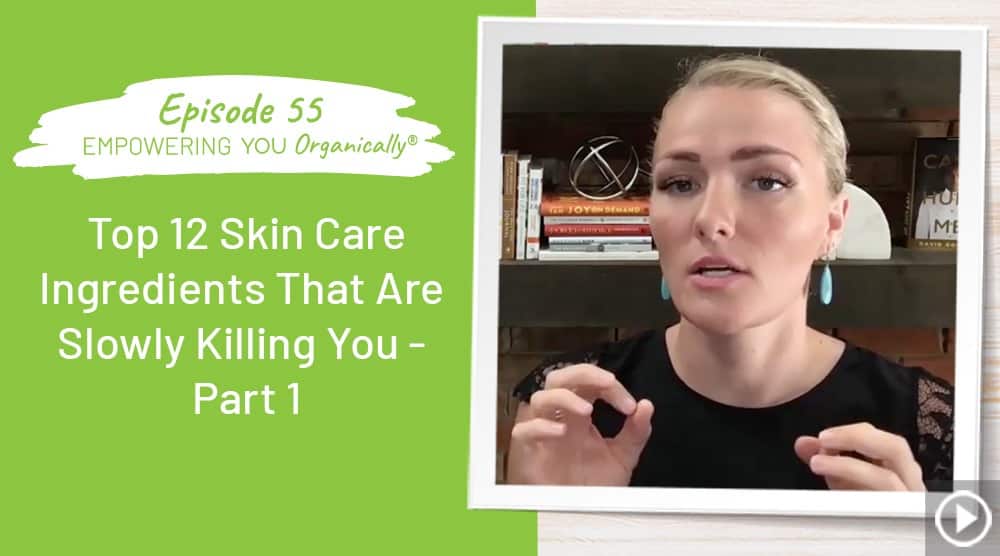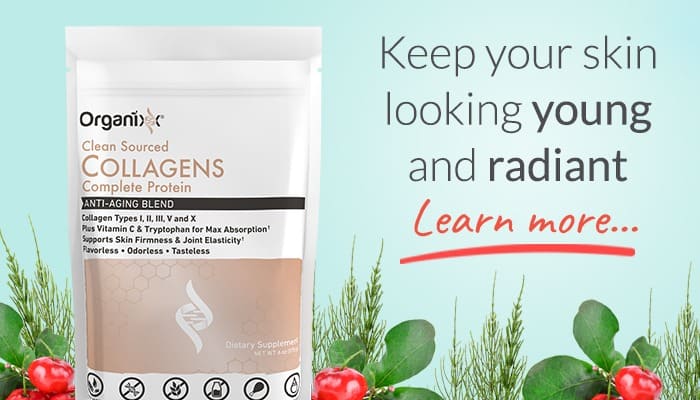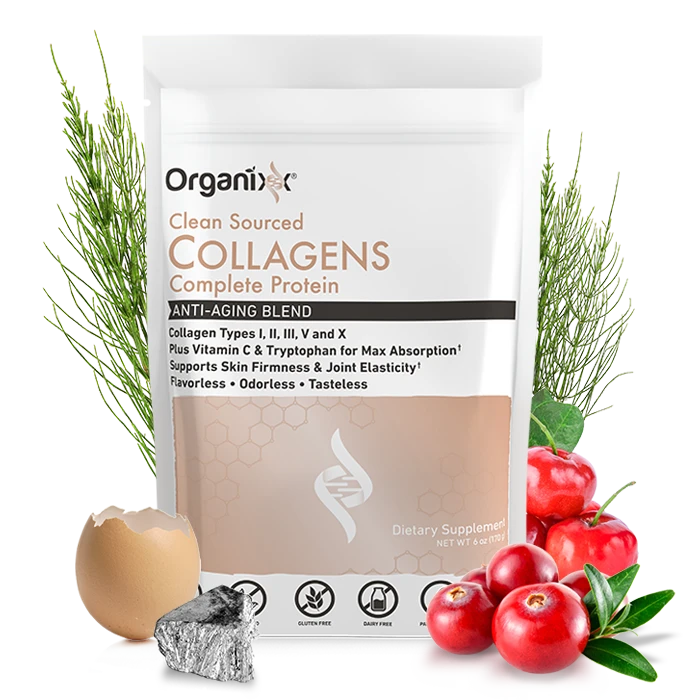Empowering you Organically – Season 7 – Episode 55
Title: Top 12 Skincare Ingredients That Are Slowly Killing You – Part 1
Hosts: Jonathan Hunsaker, TeriAnn Trevenen
Guest: None
Description: This week we dive into the murky ingredients in your skincare products. Many of these are hormone disrupters and known carcinogens. Since our skin is our largest organ and we’re all about limiting toxicity in our lives this episode was a MUST. Tune in this week to learn how to be a savvy skincare shopper!
Featured Product
- Features five collagen types from four different sources!
- Contains eight grams of protein per serving
- Help reduce the appearance of fine lines and wrinkles
- Helps ease joint stiffness and discomfort
- Formulated with vitamin C, horsetail extract, and zinc for maximum absorption
- Odorless, flavorless formula easily mixes into water, juice, or smoothies
* * *
Why Skincare Impacts Your Health
- Skin is the biggest organ on your body.
- Skin absorbs everything that we put on it.
- Skincare is one of the most lucrative industries in the world.
“Fake Skincare”
- In March of 2019, the Environmental Working Group, the EWG, reported that US regulation of chemicals and contaminants in cosmetics is falling behind the rest of the world.
- More than 40 nations, ranging from major industrialized economies like the United Kingdom and Germany, to developing states like Cambodia and Vietnam, have enacted regulations specifically targeting the safety and ingredients of cosmetics and personal care products.
- Some of these nations have restricted or completely banned more than 1,400 chemicals from cosmetic products.
- By contrast, the US Food and Drug Administration has banned or restricted only 9 chemicals for safety reasons.
- This is one of the most under-regulated industries but one of the most lucrative industries in the United States.
Why Do Regulations Matter?
- The Environmental Working Group (EWG)
- They curate the Skin Deep database of ingredients used in personal care products and their safety concerns on human health.
- Biggest advocates for clean ingredients in your products.
- If your skin care product is backed by the EWG, it means they’ve done their homework, they’ve taken the time to look at clean ingredients.
- The EWG has a scale that rates products from 1 to 5 as far as cleanliness and safety.
Top 12 Ingredients to Avoid & Why – The First 6!
|
Ingredient |
Typically Found In: | Why You Should Avoid |
| PHTHALATES (DIBUTYL PHTHALATE)
|
nail polish and other nail products, perfume, makeup remover, hairspray, deodorant
|
Phthalates are sneaky endocrine disruptors, which means they mimic the body’s hormones, therefore throwing the entire endocrine system off balance. They cause both hormonal and neurological damage, and in the case of pregnant women, may also cause major birth defects. The worst part? You will rarely find the word “phthalates” on a label.
Some products do market themselves as phthalate-free, but what about the other slew of synthetics on our department store’s beauty shelf? You can identify phthalates by their abbreviated chemical components: DBP (di-n-butyl phthalate), DEP (diethyl phthalate), DMP (dimethyl phthalate), DEHP (di-2-ethylhexyl), and BzBP (benzylbutyl phthalate). |
| SULPHATES (SODIUM LAURATE, LAURYL SULPHATE OR SLS)
|
Primarily used as a foaming agent or detergent to be found in shampoos, facial cleansers, mouthwash, toothpaste, bubble bath products, household and utensil cleaning detergents.
|
Depending on the manufacturing process, Sodium laureth sulfate may be contaminated with ethylene oxide and 1,4-dioxane. Both contaminants may cause cancer. Also, ethylene oxide may harm the nervous system and interfere with human development, and 1,4-dioxane is persistent. In other words, it doesn’t easily degrade and can remain in the environment long after it is rinsed down the shower drain.
SLS has been shown to cause or contribute to: skin irritation, canker sores, disruptions of skin’s natural oil balance and eye damage. It is also widely believed to be a major contributor to acne (especially cystic acne) around the mouth and chin. |
| PARABENS (METHYL-, ETHYL-, PROPYL-, BUTYL-, ISOBUTYL-)
|
A common and very cheap cosmetic preservative, the second most common skincare ingredient.
Found in: makeup, moisturizer, shaving gel, shampoo, personal lubricant and spray tan products
|
Synthetic parabens are toxic in large or cumulative quantities, as the body stores parabens in many tissue types. They can cause allergic reactions, skin rashes and irritation. Parabens have been shown to mimic estrogen which disrupts normal hormone function. Exposure to external estrogen’s have been shown to increase the risk of breast cancer and increase cell abnormalities. There should be no excuse for your skincare products to still have Parabens.
The FDA acknowledges several studies linking parabens, which mimic estrogen, to breast cancer, skin cancer and decreased sperm count, but has not ruled that it is harmful. According to the European Commission’s Scientific Committee on Consumer Products, longer chain parabens like propyl and butyl paraben and their branched counterparts, isopropyl and isobutylparabens, may disrupt the endocrine system and cause reproductive and developmental disorders. Look for ingredients with the suffix “-paraben” as well—paraben-free products will be labeled as such. |
| FORMALDEHYDE
|
These are primarily preservatives commonly found in cosmetics. It is also found in baby bath soap, nail polish, eyelash adhesive and hair dyes. Look for: DMDM hydantoin, diazolidinyl urea, imidazolidinyl urea, methenamine, quaternium-15, and sodium hydroxymethylglycinate. These ingredients slowly and continuously release small amounts of formaldehyde. | Short-term health impacts include irritation to the eyes, nose and throat, and many studies show it causes allergic skin reactions and skin rashes. In fact, it was awarded 2105 Contact Allergen of the Year by American Contact Dermatitis Society.
Long term, Formaldehyde has a long list of adverse health effects, including immune-system toxicity, respiratory irritation and cancer in humans. Formaldehyde is a recognized human carcinogen.
|
| BHA AND BHT (BUTYLATED HYDROXYANISOLE AND BUTYLATED HYDROXYTOLUENE)
|
Butylated hydroxytoluene (BHT) and butylated hydroxyanisole (BHA) are closely related chemicals – preservatives commonly used in cosmetics, personal care products (mainly shampoos, perfumes, deodorants, body lotions), and even food and food packaging. | The National Toxicology Program classifies butylated hydroxyanisole (BHA) as “reasonably anticipated to be a human carcinogen.” It can cause skin depigmentation. In animal studies, BHA produces liver damage and causes stomach cancers such as papillomas and carcinomas and interferes with normal reproductive system development and thyroid hormone levels. The European Union considers it unsafe in fragrance. Opt for a BHA and phthalate-free perfume. |
| COAL-TAR DYES
Polycyclic aromatic hydrocarbons (PAHs) are a group of chemicals that occur naturally in coal, crude oil and gasoline. |
Found in: hair dyes, lipstick, cosmetic, shampoo
|
Phenylenediamine, used in hair dyes, has been found to be carcinogenic in laboratory tests conducted by the U.S. National Cancer Institute and National Toxicology Program. Coal tar is recognized as a human carcinogen and the main concern are their potential as carcinogens. As well, colors may be contaminated with low levels of heavy metals and some contain aluminum (a neurotoxin). This is of particular concern when used in cosmetics that may be ingested, like lipstick. |
* * *
Subscribe to Empowering You Organically
Never miss an episode!
APPLE PODCASTS SPOTIFY GOOGLE PODCASTS
–
Episode 55 – Top 12 Skincare Ingredients That Are Slowly Killing You – Part 1





